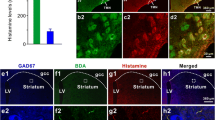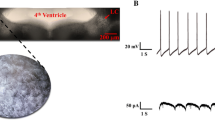Summary
There is immunohistochemical evidence suggesting that glutamate (Glu) is released from nerve terminals and acts, via several receptor subtypes, as a major excitatory neurotransmitter in the cortico-striatal pathway of the rat. Aspartate (Asp) is also present in cortico-striatal neurons, but its role as a neurotransmitter has been questioned, since, in contrast to Glu, it has not been demonstrated in presynaptic vesicles. Glu and Asp can be found at subμM concentrations in the extracellular compartment of most areas of the basal ganglia. Their concentrations are largely regulated by transport mechanisms, but also by a synaptotagmin-dependent exocytotic release, and are sufficiently high to occupy junctional and extrajunctional receptors.
We have investigated whether Glu and Asp release in the neostriatum can be selectively modulated by different neuronal systems. Dopamine (DA) and cholecystokinin (CCK) selectively stimulate Asp release, via D1 and CCKB receptor subtypes, respectively. Also opioid κ-agonists increase Asp release. We propose that the selective modulation of Asp release by D1−, CCKB- and κ agonists involves striatal neurons containing Asp, but not Glu. In contrast, local perfusion with the ,μ-opioid antagonist D-Phe-Cys-Tyr-D-Trp-Orn-ThrPen-Thr-NH2 (CTOP) increases both Glu and Asp release. This effect is probably exerted on cortico-striatal terminals, via presynaptic inhibitory μ-receptors. Thus, these results demonstrate that extracellular levels of Glu and Asp are modulated differentially by different neuronal systems, and suggest that in the neostriatum of the rat there are neuronal populations using Glu and/or Asp as messenger(s).
Similar content being viewed by others
References
Bridges R, Stanley MS, Anderson MW, Cotman CW, Chamberlin R (1991) Conformationally defined neurotransmitter analogues. Selective inhibition of glutamate uptake by one pyrrolidine-2,4-dicarboxylate diastereomer. J Med Chem 34: 717–725
Chen Y, Engidawork E, Loidl F, Dell'Anna E, Goiny M, Lubec G, Andersson K, Herrera-Marschitz M (1997) Short- and long-term effects of perinatal asphyxia on monoamine, amino acid and glycolysis product levels measured in the basal ganglia of the rat. Dev Brain Res 103
Dinopoulos A, Dori I, Parnavelas JG (1991). Immunohistochemical localization of aspartate in corticofugal pathways. Neurosci Lett 121: 25–28
Fillenz M (1995) Physiological release of excitatory amino acids. Behav Brain Res 71: 51–67
Godukhin O, You Z-B, Herrera-Marschitz M, Goiny M, Pettersson E, Hhkfelt T, Ungerstedt U (1995) Effect of local cholecystokinin-8 administration on extracellular levels of amino acids and glycolytic products monitored byin vivo microdialysis in the fronto-parietal cortex of the rat. Neurosci Lett 194: 29–32
Hansson E, Rönnbäck L (1995) Astrocytes in glutamate transmission. FASEB J 9: 343–350
Herrera-Marschitz M, Goiny M, Meana JJ, Silveira R, Godukhin O, Chen Y, Espinoza S, Pettersson E, Loidl F, Lubec G, Andersson K, Nylander I, Terenius L, Ungerstedt U (1996) On the origin of extracellular glutamate levels monitored in the basal ganglia byin vivo microdialysis. J Neurochem 66: 1726–1735
Hollman M, Heinemann S (1994) Cloned glutamate receptors. Annu Rev Neurosci 17: 31–108
Johnston GAR, Sue M, Kennedy E, Twitchin B (1979) Action of the neurotoxin kainic acid on high affinity uptake of 1-glutamic acid in rat brain slices. J Neurochem 32: 121–127
Morari M, O'Connor WT, Ungerstedt U, Fuxe K (1993) N-Methyl-D-aspartic acid differentially regulates extracellular dopamine, GABA, and glutamate levels in the dorsolateral neostriatum of halothane-anesthetized rat: anin vivo microdialysis study. J Neurochem 60: 1884–1893
Nicholls DG, Attwell D (1990) The release and uptake of excitatory amino acids. Trends Pharmacol Sci 71: 462–468
Orrego F, Villanueva S (1993) The chemical nature of the main central excitatory transmitter: a critical appraisal based upon release studies and synaptic vesicle localization. Neuroscience 56: 539–555
Ottersen OP, Storm-Mathisen J (1984) Glutamate- and GABA-containing neurons in the mouse and rat brain as demonstrated with a new immunohistochemical technique. J Comp Neurol 229: 374–392
Pettersson E, Herrera-Marschitz M, Rodriguez-Puertas R, Xu Z-Q, You Z-B, Hughes J, Elde RP, Ungerstedt U, Hökfelt T (1996) Evidence for aspartate immunoreactive neurons in the neostriatum of the rat: modulation by the mesencephalic dopamine pathway via the DI-subtype of receptor. Neuroscience 74: 51–66
Snyder GL, Fisone G, Morino P, Gundersen V, Ottersen, OP, Hökfelt T, Greengard P (1993) Regulation by the neuropeptide cholecystokinin (CCK-8S) of protein phosphorylation in the neostriatum. Proc Natl Acad Sci USA 90: 11277–11281
Tossman U, Jonsson G, Ungerstedt U (1986) Regional distribution and extracellular levels of amino acids in rat central nervous system. Acta Physiol Scand 127: 535–545
Ungerstedt U, Herrera-Marschitz M, Jungnelius U, Ståhle L, Tossman U, Zetterström T (1982) Dopamine synaptic mechanisms reflected in studies combining behavioural recordings and brain dialysis. Adv Biosci 37: 219–231
You Z-B, Herrera-Marschitz M, Brodin E, Meana JJ, Morino P, Hökfelt T, Silveira R, Goiny M, Ungerstedt U (1994a) On the origin of striatal cholecystokinin release: studies within vivo microdialysis. J Neurochem 62: 76–85
You Z-B, Nylander I, Herrera-Marschitz M, O'Connor WT, Goiny M, Terenius L (1994b) The striatonigral dynorphin pathway of the rat studied within vivo microdialysis-I. Effects of K+-depolarization, lesions and peptidase inhibition. Neuroscience 63: 415–425
You Z-B, Pettersson E, Herrera-Marschitz M, Hökfelt T, Terenius L, Nylander I, Goiny M, Hughes J, O'Connor WT, Ungerstedt U (1994c) Modulation of striatal aspartate and dynorphin B release by cholecystokinin (CCK-8) studiedin vivo with microdialysis. Neuroreport 5: 2301–2304
You Z-B, Herrera-Marschitz M, Pettersson E, Nylander I, Goiny M, Shou H-Z, Godukhin O, Hökfelt T, Terenius L, Ungerstedt U (1996a) Modulation of neurotransmitter release by cholecystokinin in neostriatum and substantia nigra of the rat: regional and receptor specificity. Neuroscience 74: 793–804
You Z-B, Herrera-Marschitz M, Nylander I, Goiny M, Kehr J, Ungerstedt U, Terenius L (1996b) Effect of morphine on dynorphin B and GABA release in the basal ganglia of rats. Brain Res 710: 241–248
Author information
Authors and Affiliations
Rights and permissions
About this article
Cite this article
Herrera-Marschitz, M., Goiny, M., You, Z.B. et al. Release of endogenous excitatory amino acids in the neostriatum of the rat under physiological and pharmacologically-induced conditions. Amino Acids 14, 197–203 (1998). https://doi.org/10.1007/BF01345262
Received:
Accepted:
Issue Date:
DOI: https://doi.org/10.1007/BF01345262




